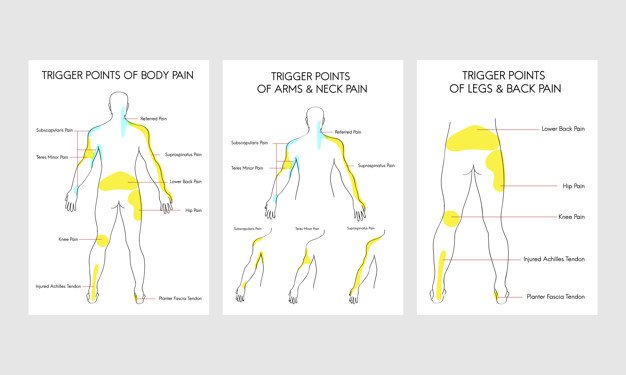Menu
Low back pain treatment can be manageable if you identify the cause of the pain. One of the common reasons for the pain is the trigger point. These aren't necessarily the areas where you feel the pain, but it often radiates there.
Before you learn how to treat your trigger points, it's essential to understand why they come about in the first place.

Trigger points (TrPs) or "muscle knots" are painful spots within the soft tissue that cause intense aching. They often become myofascial pain syndrome (MPS) if there are too many of them. They can appear like tense muscle fibers, which usually feel painful when pressed. They're responsible for sending direct sensation radiating in the lower back.
"Chronic musculoskeletal disorders may point to the rise of trigger points in different areas of the body," according to The Pain Center. Myofascial trigger points are related but can happen in softer tissues like skin, ligaments, tendons, and scar tissue.
Although the source of trigger points is unknown, research suggests several causes. Direct or indirect injury, repetitive movement (like running), or stress were several of them. Many of these speculated causes are related, such as chronic stress from injuries and change in position that is repetitive over time.
These muscle knotted areas send the signal of pain to the brain through the nervous system. They can shift from being less sensitive or flare-up in no time and can't disappear without medication. And if left untreated, it can further contribute to chronic low back pain.

Pains and aches are a widespread medical complaint, and trigger points appear to be among the many factors. They are usually involved in headaches (including migraines), low back pain, and neck pain. Trigger points cause triple threat such as:
Trigger points can bring direct pain as they're a "typical" part of muscle tissue. At some point, you'll experience some discomfort with no further explanations or issues.
Trigger points worsen injuries and other unpleasant problems. They're likely to show up in no time and start to overshadow the primary problem.
Trigger points copy other pain problems. They usually feel like something else. It can easily be assumed by an unsuspecting health professional to mistake trigger point pain for anything but a trigger point.
The critical muscles connected to the lower back that can cause pain are the: Quadratus Lumborum (QL); Multifidus; Erector Spinae; Psoas; Gluteus Maximus; and Gluteus Medius. Other muscles aren't directly connected to the lower back but can still influence its function. These include Gluteus Minimus, Piriformis; Hamstrings; and Tensor fascia lata.
Low back pain is a term commonly used by patients as a complaint. People typically assume it points to one condition, but according to therapists, this is rarely the case. Understanding how low back pain can manifest itself is crucial to address it effectively.
Here are several complaints about low back pain:
According to Trigger Point Therapist, 70% of their patients had low back pain complaints and pain in the belt-line region. The pain often manifests unilaterally, but in more established complaints, it can show bilaterally.
Pain in the sacro-iliac joint region is commonly caused by trigger point movement in some muscles. The sacro-iliac joint is unique as there are no muscle groups that directly act on it. Constant muscle tension in the adjacent muscles will induce the joint to become dislodged or dysfunctional.
Although lumbar para-spinal is a rare complaint from patients, the muscle tension in this area is common, caused by the ubiquitous lower-crossed postural distortion. Trigger points in this area will involve pain either in the thoracolumbar junction and flank regions.
According to therapists, gluteal pain is typically seen as a secondary condition to belt-line and sciatic pain complaints. Pain and tenderness in this area is usually the result of trigger point activity developed in the Gluteus Maximus muscle. Trigger points in these muscles can involve discomfort in the buttock area.
Pain that goes down the front or back of the leg can have several sources.
Disc herniation in the lumbar spine can trap the nerve roots as they exit the spine and create radiating pain, tingling, numbness, and disturbances in the leg. Patients tend to suffer from severe, uncompromising pain and present with an extreme antalgic posture, with only surgery being the only suitable option.
The most prevalent cause of sciatica symptoms is trigger point activity in the Gluteus Minimus and Piriformis muscles, which trap the sciatic nerve as it exits the pelvic region.
You can seek a physical therapist if you have access and have the means to have such assistance. Otherwise, take the time to massage the muscles, as mentioned earlier, and muscle groups to determine where the tension and source of pain are derived.
This specific activity is needed during the treatment phase and continued continually for prevention. Ideally, a physical therapist recommended stretches, but, again, there are options if you don't have access to one. We listed a few well-informed low back pain stretches to help you relieve from pain and discomfort in your muscles.
Drinking lots of water is essential when you perform stretching exercises. It helps to release and flush out possible water retention caused by previous muscle trauma or strain for repair.
Certain dietary deficiencies (such as low Magnesium), increase tension in the muscles since they cannot receive the proper nutrients for optimal function. Iron is also an issue for menstruating women since it sustains oxygen throughout the body.
You must get lab testing done to identify your deficiencies. If you haven't and still need to have a confirmation for defects, never supplement without proper care of a physician, as Vitamins and minerals can cause an overdose. An increase in Magnesium can affect your Calcium and vitamin D levels and vice versa. An increase in iron can also affect vitamin C levels, so be always be mindful.
Acquiring at least 7 hours of sleep is necessary for adults and at least 8 hours for young adults and children.
As you wake up, pay attention to whether you're experiencing any soreness or discomfort.
A great way to support your body during the night is placing a pillow between your knees maintain your spine in a healthy level. Sleeping on your back is also an excellent position, which you can further support by putting a knee pillow as well. A much as possible, try avoiding sleeping on your stomach. This position is the least supportive position for your spine from the cervical to the lumbar regions.